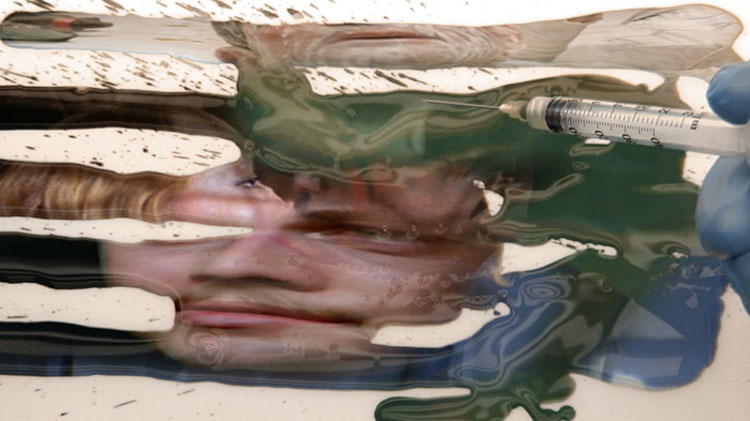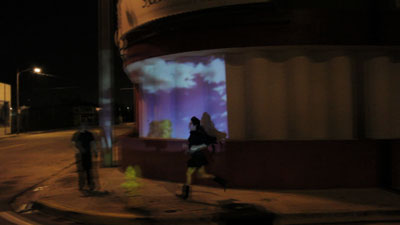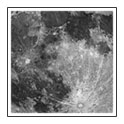 PHOTO: Photo courtesy of the de la Cruz Collection Contemporary Art Space, Miami
PHOTO: Photo courtesy of the de la Cruz Collection Contemporary Art Space, Miami
Martin Murphy, Film Spills, 2010, video, 2 minutes 31 seconds Fighting Kissing Dancing at the Fabric Workshop
By J. MAKARY
Posted: 8/14/11
Fighting Kissing Dancing, a 12-minute loop of videos curated by artist Carlos Rigau, loosely brings together the work of 7 artists with ties to Miami. The show has a stated theme—fighting, kissing, and dancing are identified as actions traditionally used in narrative film for emotional effect, and the show's press release explains, rather vaguely, that these artists explore "ideas surrounding the human form, its interactions and intimacies.” However, don’t expect much narrative, or comment on narrative conventions, from the bulk of these video works. The show brings together such disparate works (some of which contain—in place of fighting, kissing, or dancing—swimming, running, or putting on socks) that it seems the only recourse is to think about each work singly rather than as part of a thematic exhibition with common goals or theoretical inclinations.
Interestingly, the best works in the show push the boundaries not only of narrative conventions but also of formalist approaches to (and the medium specificity of) cinema. Martin Murphy’s “Film Spill” uses the curious device of a hypodermic syringe to expel little pools of “liquid video” onto the screen. Bubbles form in the glistening surfaces of the spills while cliché-driven scenes from commercial Hollywood films play within their borders, blending their colors and light in such a way as to reduce the elements of cinema to slippery, paint-like material. Sound, too: engineered for the stereophonic rush of the movie theater, the music, dialogue, and sound effects crash into each other and intermingle. At its climax, Murphy's video reads like a wall of televisions creating visual and aural chaos on the showroom floor of an electronics store. The work plays with the surface implied by the screen, for a contemporary take on structural-materialist film. Historically such films drew attention to the flatness of the screen and the process of projection by shunning any attempt, including narrative, plot, and recognizable actors, to draw viewers into illusionistic content, concentrating instead on the formal and material characteristics of celluloid film or the filmmaking process. By using digital postproduction software to literalize the surface of the screen, Murphy employs some of the newest technology in a continuation of the structural-materialist tradition: his is a structuralist approach to special effects. That he uses found-footage clips from the realm of commercial cinema—themselves full of illusionistic content (and explosions!)—Murphy's piece takes a swing at the conventional and the avant-garde in one deconstructing gesture.
 PHOTO:Photo courtesy of the de la Cruz Collection Contemporary Art Space, Miami
PHOTO:Photo courtesy of the de la Cruz Collection Contemporary Art Space, Miami
Jillian Mayer, Scenic Jogging, 2010, video, 1 minute 19 seconds In “Scenic Jogging,” a conceptually riveting piece by Jillian Mayer, a woman takes to the streets in pursuit of a series of projected screensavers of the type that come standard on a Dell computer. Photographically engineered to be soothing, these aids to daydreams of office workers have as a side effect a kind of bland perfection that undermines their promises of escape. Yet Mayer’s heroine pursues them with intensity, running single-mindedly and fixing her stare straight ahead. Backed by a musical soundtrack, she pumps faster, trying to intercept the image as the projections pass over—and encompass—the Miami streetscape. The night is quiet, still; occasionally, a bewildered pedestrian is momentarily engulfed by Mayer’s performance, and these moments give the video a live, spontaneous quality. The video gets a succinct entry into narrative from the runner’s street clothes—a dress, cowboy boots—and her unflagging purpose. With these barest suggestions, Mayer inserts the viewer into an unexplained narrative that wastes no time in getting the viewer to wonder who this woman is, where she has just been, and what motivates her to chase down these scenes projected from a car. Mayer's simple approach achieves something complex, giving viewers the feeling that something is at stake, right now, in the moment. Similar to "Film Spills," "Scenic Jogging" experiments with the idea of surface-as-material, mapping the flatness of the projection onto the contours of the passing world. The screen(saver) has no content, but the mysterious runner suggests a story with a beginning and ending stretching out beyond this humble sliver of narrative.
Aside from a remarkably diverse range of approaches to sound design, the rest of the videos in Fighting Kissing Dancing presumably have little to offer viewers who get a steady diet of video art. What’s in a name? A curatorial priming that leads to a set of expectations—in a way, the title is the first work in an exhibition. The ample strengths of Mayer's and Murphy's work notwithstanding, Fighting Kissing Dancing is thematically inert, watered down by the vagueness of its premise.
Fighting Kissing Dancing (an exchange with the de la Cruz Collection Contemporary Art Space in Miami)
The Fabric Workshop and Museum
www.fabricworkshopandmuseum.org
1214 Arch Street
Philadelphia, PA 19107
On view through late Summer 2011
|
|





